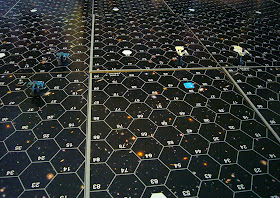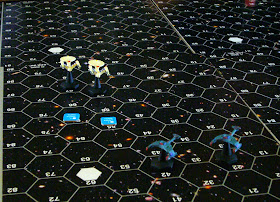I guess my gaming buddies and I are currently on a sci-fi kick lately. My last post was a recap of Twilight Imperium. Today, I'll tackle Federation Commander--Klingon Border.
Okay, this game has been out for nearly a decade, but none of us have been able "boldly go" into this latest variant of Star Fleet Battles (SFB) until now. Of the five of us that gathered this past weekend, (Dan, Dale, Dallas, Daniel--The D4s?--and I), three of us grew up playing SFB back-in-the-day when it started as a pocket edition for about $5.
Now all of us like SFB, and still reminisce about our games-of-yore, which included self-made campaigns involving planetary economies and fleet actions that took entire weekends to play out.
But--many of us didn't like the complex space amoeba SFB morphed into--something that would absorb all of one's free time to merely studying the rules just to keep up with the latest changes/editions/addendums/errata/new ships/bizarre new races/etc.
While SFB certainly deserves it's induction into the Academy of Adventure Gaming, Art & Design Hall of Fame, I think the only people who play continue to play SFB only play SFB and very few--if any--other games.
For the rest of us weary souls, Federation Commander (FC) has been a welcome oasis in the Desert of Rules Complexity. I could go on & on about the differences between SFB and FC, but instead, just think of it as a leaner & cleaner version of SFB.
Gone are the rules that added to SFB's ever-growing complexity. Although many of us actually liked SOME of the rules that were jettisoned from the Rules Revision Airlock. I for one liked transporter bombs, legendary crews and officers, along with the fast attack boats (horrendously termed as "pseudo-fighters"). But, desperate means calls for desperate measures and all that.
And speaking of discarding unwanted baggage, when FC hit the game store shelves, many of us jettisoned our SFB collection, albeit with mixed feelings. Rest assured though, it's not like we ceremoniously burned our old SFB collection in a funeral pyre. Instead, we found them good homes via E-bay, used game outlets, or pawned them off on friends.
Now, enough of the Memory Alpha research and on to our game at hand, starting with the set-up...
I set up the board the night prior along with all the counters I thought we'd need. FC provides two sets of counters: The traditional color-coded 1/2-inch and the ship-paint scheme 1-inch counters. I was intending to play using the 1 inch counters, until Dale surprised us with his collection of what can be basically described as prototype miniatures. (The current standards are the Starline 2400 Series, the Starline 2425 Series and the Starline 2500 Series).
I have a small painted collection, which I bought from Dan a couple years back. However, I really liked Dale's collection since the figures fit so well on to the 1-inch hexes. Sadly, these miniatures didn't make it that far past the "prototype" stage and are of limited variety, consisting primarily of cruisers.
This being the case though, we decided on a cruiser vs cruiser duel, pitting two Federation heavy cruisers (CAs) captained by Dallas and I, against two Klingon D-7 Battlecruisers (BCs) initially ruled by Dan and Dale. Daniel arrived later, "staged a coup" on Dan's ship, so Dan became the game's Rules Guru.
Here's the ensuing action that followed (comments on the rules are in blue):
The heavy cruisers Quernado and Prado Verde, (named after two tiny towns in Texas; population 261 and 213, respectively), were on patrol in a contested volume of space somewhere "out in the black."
(Cue Klingon "Battle Music").
The IKVs (Imperial Klingon Vessels) Blood and Gore, raced across the border.
All vessels immediately launched drones (another SFB term I hate and prefer to simply call them missiles).
These, along with the powerful plasma torpedoes employed by the Romulans and Gorns, are classified as seeking weapons. That is, they're represented by counters and home-in on their targets. These weapons can be annoying at best, diverting much-needed phaser power towards defensive fire, but deadly at worst once they impact.
But before these seeking weapons either impacted, or were destroyed by defensive fire; the Quernado and Blood exchanged phaser and heavy weapons fire, disruptors for the Klingons and photon torpedoes from the Federation.
I have mixed-feelings about photon torpedoes, which unlike the plasma ones, are considered direct-fire weapons. Which means, once they're fired there's nothing the target ship can do to stop it from impacting. Provided of course--they actually hit. Plus, unlike Klingon disruptors, photon torpedoes take two turns to load, arm and fire.
The Quernado got the worst of it in the initial volley, which destroyed the #1 (forward) shield. "Fortunately," when the drones struck, one was taken out by defensive fire, while the survivor impacted against the #6 (left-forward) shield.
Another nice thing about FC, is the Ship System Displays (SSDs) are pre-laminated and color-coded, as seen here:
Some ships are more maneuverable than others, based on their turn mode. A turn mode number is the amount of hexes (considered to be 10,000 kilometers wide) vessels have to move forward, before it can turn. The faster any ship goes, the harder it is to turn. To keep track of when and where a ship previously turned, "turn point" counters are utilized.
Here the Klingon and Federation cruisers exchanged some medium-range volleys.
Ships can also "slip." That is, do something of a forward-side sashay, which provides some additional tactical maneuverability. A ship has to move forward one hex before it can slip again, so "slip point" counters are used.
Remember what I said about some ships being more maneuverable than others? Well, the Federation CAs are some of the most well-rounded ships in the game, designed for a "...five year mission, to explore strange new worlds, seek out new civilizations..." etc, so on and so forth. Unfortunately, this makes them less maneuverable than their Klingon counterparts, designed only to subjugate and conquer.
So the Blood and Gore got behind us...
...and closed fast.
Most games of SFB/FC often devolve into a point-blank, do-or-die furball. Our game was no exception.
In this case, it was the Quernado and the Blood traded blows with overloaded heavy weapons (increasing the firepower up to twice the normal yield). Meanwhile, the Prado Verde and the Gore exchanged a shot or three.
At the end of the mutual salvo, the Quernado looked like this...
...while the Blood was also hemorrhaging fuel and oxygen, along with anything--or anyone--that wasn't bolted down.
The Prado Verde exchanged more shots with the Gore..
...and slipped past both Klingon cruisers, because at this point everyone fired-off their weapons.
Damage control parties on every ship were now gainfully employed. So it was a race to see who could repair weapons and power systems first. As the Blood closed-in on the Quernado...
...the Gore and Prado Verde once again traded some side-shots.
Eventually though, the Gore got behind the Prado Verde and launched two drones (not seen in this picture).
At 10,000 kilometers, the Blood's damage control parties repaired enough weapons...
...to blast the Quernado to atoms.
Prior to the "furball moment," both Federation cruisers were forced to make high-energy turns (HETs) in order to obtain better firing positions.
An HET allows a vessel to turn in any direction, and according to the FC rules, all ships are allowed to make one HET with no consequences. After this freebie though, any time a ship makes a subsequent HET, it has a 50% chance of suffering a breakdown.
With two drones bearing down on the Prado Verde's #4 (rear) non-existent-due-to-battle-damage shield, the Federation cruiser was forced to make another HET, otherwise it couldn't outmaneuver the drones.
Unfortunately, the Prado Verde pressed it's luck too far and suffered the dreaded breakdown. On the "plus side," the drones impacted the fully operational #6 shield. By this time, both ships suffered heavy damage.
Well, since V'Ger wasn't on hand to handle the Klingons, the Federation certainly lost this encounter. How badly depends on whether you ask a Klingon or Federation player.
The Prado Verde was either:
a. Finished off by the Gore, or
b. Managed to disengage.
Since I'm writing this--yes--Federation biased battle report, I'm going with "b." the more "happier ending."
But for you Klingon aficionados out there: Here's a fine selection of celebratory music for you to do your victory dance to.
Final thoughts on Federation Commander game-play:
Both "SFB Old Spacers" and "Cadets" among us really enjoyed Federation Commander.
If you've played SFB for any length of time, you'll immediately understand the combat mechanics of FC, which is nearly, if not outright, identical to SFB.
When I initially read the movement mechanics section, I had some trouble comprehending the changes, until we actually started playing. Basically, movement went from a 32-impulse simultaneous movement mechanic, to an 8-impulse one, with each impulse containing 4-"sub-pulses." I know this sounds confusing just reading it, but trust me, once you play a turn or three, it will (should?/maybe?) make sense to you.
You might find other aspects of FC's rules that require a hands-on game session to understand.
What us old spacers also liked about FC was the streamlined power allocation and book keeping. There's no longer any need to write orders to allocate power to the shields, sensors, scanners, life support, food synthesizers...okay I'm exaggerating about the food synthesizers. But as any SFB player can attest to, SFB required a lot of book keeping that one felt they might as well toss in a point of power to keep the crew fed. And keep in mind--this is just for one ship.
Now in FC, all this stuff--minus the food synthesizers--is "factored in." That is, it comes from the nebulous "somewhere" in the engineering section.
This makes for more responsive and streamlined decision making.
All of us look forward to playing again.
Even us Federation players.























Freaking awesome review!!!
ReplyDelete